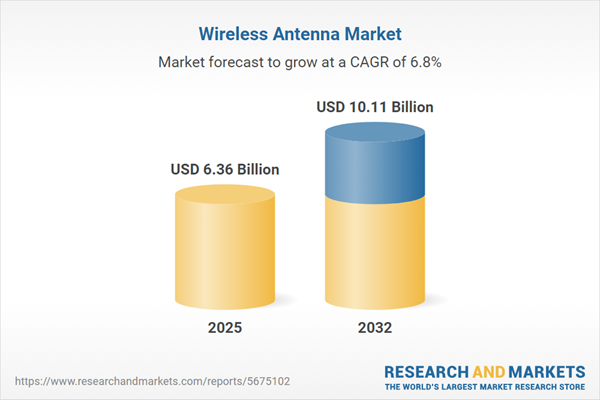Speak directly to the analyst to clarify any post sales queries you may have.
Senior executives in fast-evolving industries are encountering increasing complexity as the wireless antenna market advances. Modernization and strategic investment decisions are crucial to support reliable, scalable connectivity, ensuring organizations are equipped to lead amid changing regulatory environments and rapid technological innovation.
Market Snapshot: Wireless Antenna Market Growth and Outlook
The wireless antenna market is experiencing sustained growth, with projected market value set to steadily rise from 2024 to 2032. Expansion is fueled by the global deployment of 5G infrastructure, accelerating adoption of IoT solutions, and strong momentum in automation across commercial and residential settings. Strategic focus is directed toward antenna technologies that deliver dependable connectivity, high network capacity, and energy efficiency. Enterprises are leveraging robust antenna solutions to enable stronger network performance and operational continuity as application environments expand and use cases diversify. In this context, organizations advancing their wireless networking capabilities are positioned to respond effectively to emerging opportunities in the wireless antenna market.
Scope & Segmentation: Strategic Clarity for Decision-Makers
- Product Types: Directional antennas, omni directional models, sector antennas, and Yagi antennas give organizations flexibility for aligning performance to unique operational and connectivity needs across varying deployment contexts.
- Frequency Bands: Offering both millimeter wave bands (26 GHz, 28 GHz, 60 GHz) and sub-6 GHz options (2.4 GHz, 3.5 GHz, 5 GHz), the market supports diverse requirements, balancing wide coverage with dense data transmission.
- Deployment Modalities: Indoor and outdoor installations—on ceilings, walls, rooftops, poles, and towers—support the expansion of wireless infrastructure in commercial, industrial, and remote locations, ensuring reliable network access under diverse site conditions.
- Technologies: Innovations including beamforming, advanced MIMO (2x2 to 8x8), phased array systems, and smart antennas enhance network throughput, accuracy, and scalable communications for both centralized and distributed environments.
- End-User Industries: Key sectors encompass education, IT and data centers, retail, government and defense, healthcare, telecom, and transportation, all relying on sophisticated antenna infrastructure to sustain critical connectivity and business operations.
- Applications: Wireless antennas support fixed wireless access, industrial and consumer IoT, point-to-multipoint, and point-to-point communications, underpinning resilient and flexible connectivity for essential enterprise workflows.
- Key Regions: Central demand is anchored in the Americas, Europe-Middle East-Africa, and Asia-Pacific, with substantial investment driving connectivity across urban centers as well as advanced technology clusters in these regions.
- Companies Analyzed: The report features Huawei, Ericsson, Nokia, Samsung, Qualcomm, ZTE, CommScope, Amphenol, Cobham, and Kathrein Werke KG, highlighting their initiatives and the changing landscape of market competition.
Key Takeaways: Critical Insights for the Wireless Antenna Market
- Enhanced beamforming and phased array antenna technologies are offering more options for indoor and outdoor deployment, enabling extended coverage across urban and remote environments.
- Manufacturers are advancing sustainability through modular designs and eco-friendly materials, increasing regulatory compliance and improving product lifecycle management for enterprise customers.
- Rising demand for directional and sector antennas is meeting the need for higher capacity in base station deployments, while omni directional antennas remain integral for widespread IoT and day-to-day connectivity.
- High-frequency antenna solutions are supporting improved flexibility in metropolitan networks, as established product types provide consistent connectivity in rural and less densely populated areas.
- Asia-Pacific is solidifying its leadership in wireless deployments through progressive investments in smart city and industrial IoT initiatives, boosting early technology adoption and innovation.
- Industry leaders are reshaping supply chains and building new partnerships to accelerate adoption of software-defined antennas and maintain alignment with evolving regulations.
Tariff Impact: Supply Chain and Technology Shifts Post-2025
The introduction of post-2025 US tariffs has transformed the wireless antenna supply chain landscape. Companies have diversified sourcing, expanded local production, and embraced automation to sustain operational stability. Improved procurement transparency now gives organizations clearer oversight of components and more predictable cost management in response to shifting market dynamics.
Methodology & Data Sources
This analysis incorporates in-depth interviews with executives, insights from antenna engineering specialists, and comprehensive regulatory and manufacturing data reviews. All findings have been rigorously peer-reviewed and validated to ensure decision-makers receive accurate and valuable intelligence for the wireless antenna market.
Why This Report Matters for Senior Decision-Makers
- Provides actionable insight into current competitive positions, shifting regulatory requirements, and best practices in supply chain strategy for effective leadership.
- Equips executives with detailed analysis of technology trends and market segmentation, supporting business growth evaluation, risk management, and operational alignment.
- Informs strategic investment and portfolio decisions, enabling organizations to achieve resilience and continuity amid continued industry transformation and demand shifts.
Conclusion
As the wireless antenna sector evolves, organizations that anticipate trends and proactively align strategies will sustain growth, strengthen performance, and reinforce their competitive positioning in the market.
Additional Product Information:
- Purchase of this report includes 1 year online access with quarterly updates.
- This report can be updated on request. Please contact our Customer Experience team using the Ask a Question widget on our website.
Table of Contents
3. Executive Summary
4. Market Overview
7. Cumulative Impact of Artificial Intelligence 2025
List of Figures
Samples

LOADING...
Companies Mentioned
The key companies profiled in this Wireless Antenna market report include:- Huawei Technologies Co., Ltd.
- Telefonaktiebolaget LM Ericsson
- Nokia Corporation
- Samsung Electronics Co., Ltd.
- Qualcomm Incorporated
- ZTE Corporation
- CommScope Holding Company, Inc.
- Amphenol Corporation
- Cobham plc
- Kathrein Werke KG
Table Information
| Report Attribute | Details |
|---|---|
| No. of Pages | 196 |
| Published | October 2025 |
| Forecast Period | 2025 - 2032 |
| Estimated Market Value ( USD | $ 6.36 Billion |
| Forecasted Market Value ( USD | $ 10.11 Billion |
| Compound Annual Growth Rate | 6.8% |
| Regions Covered | Global |
| No. of Companies Mentioned | 11 |









